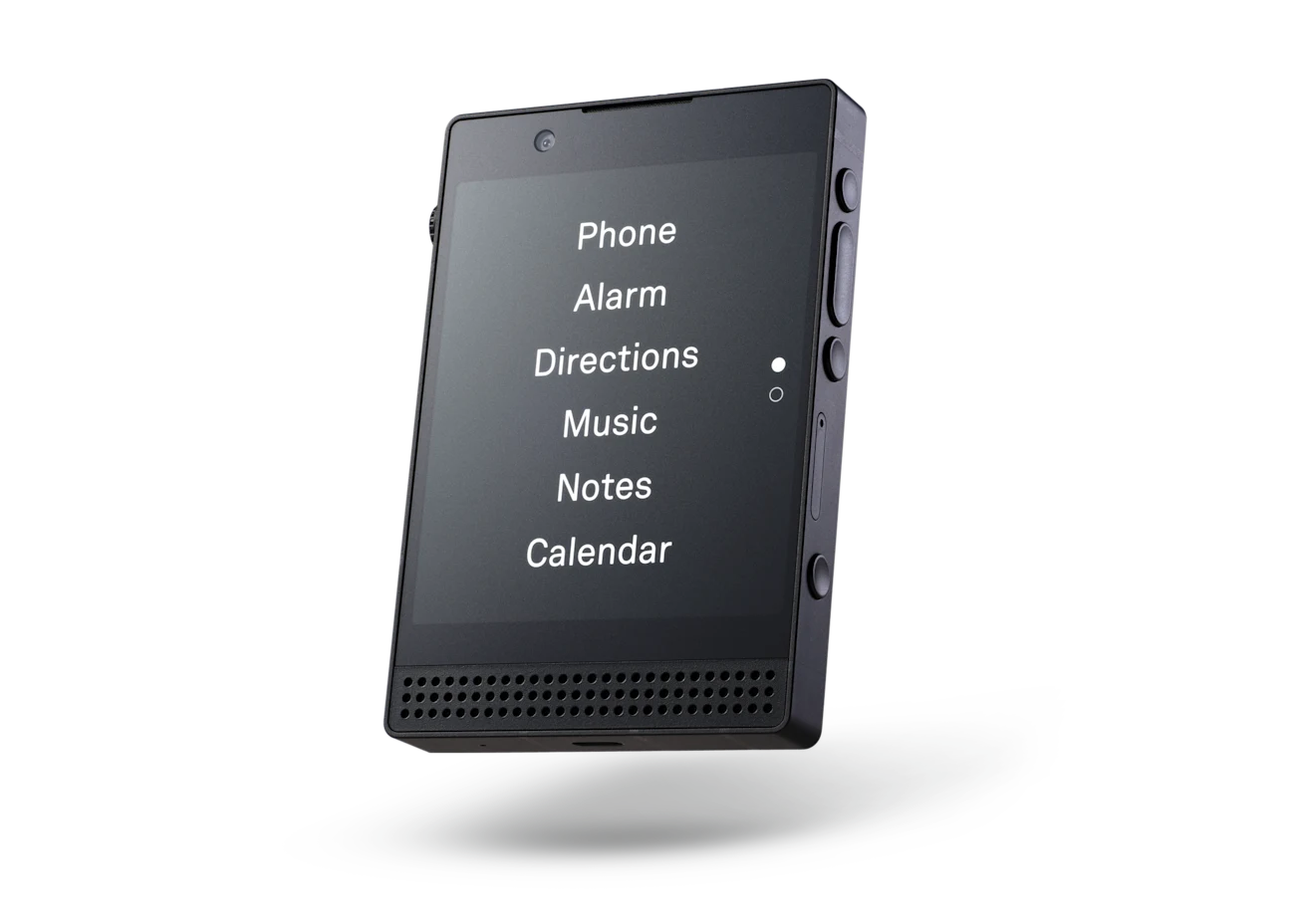Writing about tech stuff that I want serves a dual purpose: I get to feel productive by writing, and later, when I inevitably pull the trigger, I can pretend the purchase was an investment in journalism, the arts, and humanity. $200 might seem like an unreasonable price for a keyboard, but in my mind, that expenditure would actually be tithing, for all practical purposes, so long as it netted one of my fine Substack posts.
However, today’s article is a twist on the old pattern. In all the time I spend reading about stuff I want, once in a while I come across some expensive, cutting-edge things that I don’t want. Today is a day to write about emerging tech that is stupid, I don’t want, and furthermore, the failure of which I’ll enjoy. Let’s get started.
Lite Phone III: $800 Virtue Signaling Device
I’ll begin by calling out a really dumb product category that’s building momentum lately: High-end, stylish, dumb phones.
Have you ever heard of one of these? It’s a mobile phone that has very limited capabilities, yet still manages to cost lots of money. It makes precious little sense at first, but when you think about it more, it makes even less sense.
The leading brand of dumb phone is Lite Phone. There are other brands, but I’ve not researched them, as Lite Phone has produced enough nausea to suffice.
So, there’s already been the Lite Phone II, which is a couple years old and costs $300. That one made a big splash here on Substack a couple years back, with some highly trafficked articles, giving glowing reviews. The discussion is now resurfacing with the newly released Lite Phone III, selling for $800.
Both of versions of the Lite Phone have undeniable charm as tech gadgets - they look like they’d be fun to hold. People will notice them as distinguished, unusual, and expensive looking, when you pull it out of your pocket. These devices have that minimalist style which I do love very much, with their black and white interface and all-around lack of clutter.
But enough praise. These things are a big dumb ripoff. Here’s why:
1: Any Smart Phone Can Be a Dumb Phone
There are settings and apps that can turn your iPhone into a “dumb phone”. You can delete or hide apps to your heart’s content. You can turn the whole interface grayscale, thus robbing the device of all its wily, casino-inspired, dopamine priming tricks of luring you into addiction with flashing lights and colors.
You can also do this with an Android. I recently acquired a Motorola smartphone - that can run laps around a Lite Phone in capabilities - for $35. We use this device, with no service, as simply our kitchen counter, hill-billy version of a home smarthub, pulling recipes, streaming music to a Bluetooth speaker, and operating smart bulbs. At such a low price, this entry level plastic phone is notable because:
Its disposable nature makes it a wonderful enterprise device option to issue as an untraceable burner phone to the foot soldiers of your complex organized criminal endeavors.
The $35 price point compares extremely well to the $800 Lite Phone III.
Of course, the issue may simply be that you have no self-control, and you won’t have the discipline to keep the apps off and the screen grey. Fine. If you fear the temptation of the Moto’s luscious colorful screen is too much for your defenses, you know you CAN just go and get a flip phone, text with T9, and relive the glory of 2005 again. This too will drive noteworthy favorability in your family’s phone device budget, when compared to Lite Phone products.
Bottom line: You can dumb down any existing smart phone. So… everybody already carries a device that can mimic the primary use-case feature of the Lite Phone. That is quite a fatal flaw in the Lite Phone business model. But wait - there’s more!
2: Poor Peasants Like Me Actually Need Apps
When people give glowing reviews of the Lite Phone (inherently hypocritical - the reviews should be grayscale and dim, not glowing, if they’re serious about this), they’ll mention how it is so freeing, and how they have more time for other things, can be more present, and have less anxiety, etc.
I believe it! It sounds familiar. Reminds me of how I’ve felt while my wife and I have vacationed in Mexico. I don’t have service there, so I’m not able to use my phone. It is very freeing, and some of my happiest memories are from those trips.
The key word here is I was on VACATION. I wasn’t, you know, working and being a responsible adult who contributes to society. Not paying bills, sending emails, ordering rides, planning the week, tracking progress on when my kid pooped last, or otherwise problem solving. On vacation, I was all-around spared the messy trials of life on this earth.
I agree, it was really nice, being phone free. A wise dinosaur once said, “If all of our Mondays were Saturdays and Sundays, oh what a world it would be.” Full disclosure, I’ve not researched whether Barney said that, but it’s a line from a cover of his song on my kid’s Pandora station, and now that garbage is stuck in my head. The point is I can’t be on vacation all the time. Only in toil do I eat the fruits of the ground… but that’s not my iPhone’s fault. The iPhone only helps me have more time for the important things.
In the real world, us grown-ups use our smart phones for things other than Tik Tok. Below a very elite tax bracket, the following law applies: The smarter the smart phone, the higher one’s quality of life.
What I’m saying is that if you’re an adult who lives in reality, you can’t carry a dumb phone. If you’re using a dumb phone and getting away with it, that probably means you’re independently wealthy and don’t have real responsibilities, or maybe you’re just off-loading that stress onto the grown-up smart-phone carrying adults who surround you. You’re a parasite. A big hungry tapeworm with a snooty, minimalist phone.
3: It’s Annoying Performative Morality
Here in the Substack community, the dumb phone gets a particularly high amount of attention. That’s because many of the loudest, most promoted voices on the “Substack Notes” social media platform tend to fancy themselves a little offbeat and analog. They see Substack as an off-ramp from the modern, algorithm-driven digital age, and a counter-cultural movement toward a slow-paced utopia, where people read long-form content and everyone gets along.
These are people who are prone to casually mention they attend a weekly book club, and support local artisans at the weekend Farmers Market (aka paying premium prices for greasy carnival food and Chinese garbage from Etsy merchants - there are rarely any farmers at such markets - don’t get me started).
The Lite Phone appeals to that spirit - at least as marketed - of being an alternative to whatever this hamster wheel of social media and smart phones is. The marketing pitch is that getting rid of your smart phone makes you a better person. They say as much on the landing page for Lite Phone. Pardon the very small print:
Me personally, I think smart phones are good. I’m glad they’re here - a net positive for humanity. Yup, the world might have some problems, but it’s not smart phones’ fault. Many people blame smartphones on a whole host of troubles, from toxic political discourse, to broken families, to mental illness.
But correlation does not prove causation. Yes, lots of people are anxious or depressed, and kids don’t know how to behave, and at the same time, everyone has smart phones. It’s like, “Have you noticed how there are all these bad things in the world, and people doing mean things to each other? Well what else do you notice?? Everyone has smart phones and social media. Kill the smart phones!”
Silly reasoning. Next topic.
The Apple Vision Pro: Apple Finally Jumped the Shark
Speaking of devices with an imaginary use-case, I couldn’t be happier to see the Vision Pro failing. In case you forgot, the Vision Pro is a big dumb-looking piece of equipment that you strap to your face. It’s another device promising an escape from messy reality, but whereas the aforementioned dumb-phone takes you completely offline, the Vision Pro uses the opposite approach of total immersion.
I think that from the very day I was old enough to follow technology news, virtual reality (VR) has been a promised life-improving gadget of the future, with cinematic sci-fi allure. While it’s true the that science fiction does often inspire the engineering of real-life technology, there are some notable concepts that just don’t work in reality.
File VR along with humanoid robots and flying cars as something that, once we have the tech to make it happen, just aren’t as useful as we’d imagined.
When the Vision Pro launched, there were a lot of scoffers. Particularly with its $3,500 price tag. But the Apple fan-boys were quick to look back in history, and observe there was similar scoffing at the launch of the iPhone (too expensive! who needs it!) and the iPad (too expensive! we already have phones and computers!). The iPhone and iPad actually did revolutionize the way people interacted with computers, and put the haters to shame.
The Vision Pro was expected to do the same, as hard as it was to imagine.
It does, from what I read, carry some truly fascinating technology that feels like magic when you first try it. There are all sorts of cameras and sensors that study your hands and your eyeballs and figure out precisely where you’re looking, so it performs electronic witchcraft of seemingly reading your mind as you can look at things and make finger gestures in the air to interface with it.
Pretty cool, pretty cool.
But here’s the thing. Steve Jobs wasn’t a guy who would green light “pretty cool”. And Steve Jobs was the guy green-lighting and orchestrating the development of the iPhone and iPad. Doubt he would ever have put his brand’s name on the clunky-looking, half-baked concept of Vision Pro. Just seeing the thing, and hearing complaints about it being uncomfortable, there’s simply no way to reconcile it with the whole “paint the back of the fence” ethos.
As it turns out, a year and quarter later, I have never observed one of these headsets in use in the wild. I have no acquaintance who owns one.
It did not catch on, and the last I heard, the product is now in a death spiral, as developers aren’t willing to design apps to work with it. So it’s pretty much over now. Just too big, too expensive, and too immersive. Even with all of the funding and will-power of Apple’s reputation, VR has not caught on, except as a niche gaming genre. An utter, embarrassing, unprecedented failure for Apple.
Big schadenfreude from me!
VTOL Taxis… Nope
Funny that I brought up flying cars in my disparagement of the Vision Pro. Subsequent to writing that sentence, I learned that there’s currently a TON of money being spent on flying cars. Check out Joby Aerospace, or the Air Taxi by Wisk. In my recent return to the aerospace industry, my new job serves me hundreds of industry headlines a week via email, and I’m committed enough to this line of work that I, for the first time in my life, do some actual industry reading.
And today, that reading provides blog fodder, because every day I’m learning about the progress from different companies on what are called VTOL aircraft for the general public. VTOL stands for Vertical Take-Off and Landing, and seems to typically manifest in a concept of what is a cross between an enormous (think human passenger-carrying) version of the sort of multi-rotor drones that obnoxious guys fly in parks, plus a V-22 Osprey, with its helicopter-to-airplane Optimus Prime sort of transformation trick.

There are serious people out there spending way too much money racing each other to make these things a reality, intended as every day transportation.
Had a few more beers than you’d planned at the Christmas party, and need to get back across town without driving? Call a flying, robotic, Uber! What could possibly go wrong?
No. That’s ridiculous. My opinion on helicopters is that if Kobe couldn’t manage to safely use it as a daily driver, then neither can any of us. Having multiple rotors is touted as a safety advantage for VTOLs (if one goes out, it can keep flying) but I see it more like a string of Christmas lights, where if one goes out, they all go out, and the thing doesn’t have real wings to glide, so it still drops like a rock.
I’m all in on Tesla FSD (Full Self Drive) mode, and I don’t mind sharing the roads of Phoenix with our driverless Waymos (MAJOR upgrade over Arizona drivers). But just because we have smarter robots, and better electric motors, that doesn’t mean we got rid of gravity. Hard pass.
Conclusion
So there you have it. My generous sharing of writing talent is complete for the day. If it’s not a gift to humanity, I hope the courts would at least recognize this as 2 hours of community service. Dumb phones, VR headsets, and UAV taxis are all technologies that we don’t need. I propose that the development resources that are being poured into these viral strains of innovation be redirected to something more useful, like a better revision of Mario Kart.
If there’s anyone out there who is so insufferable that they’ll spend $800 to become smugly unreachable, and $3,500 to look like they’ve got a View Master strapped on their face, then I nominate such a person to be a beta tester for unmanned VTOLs.





